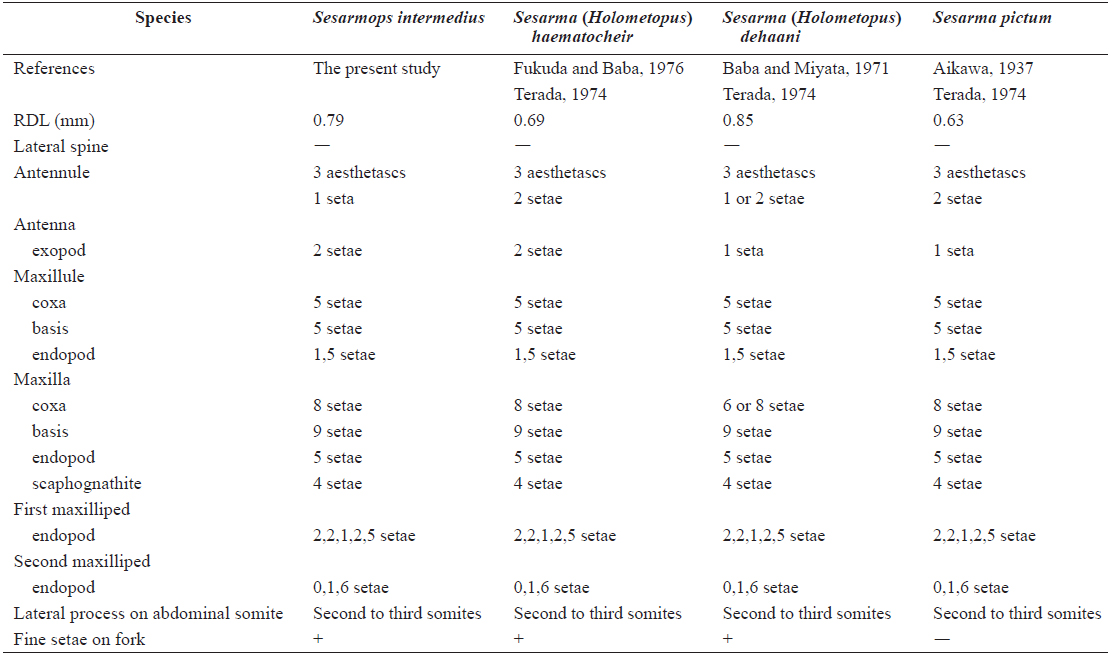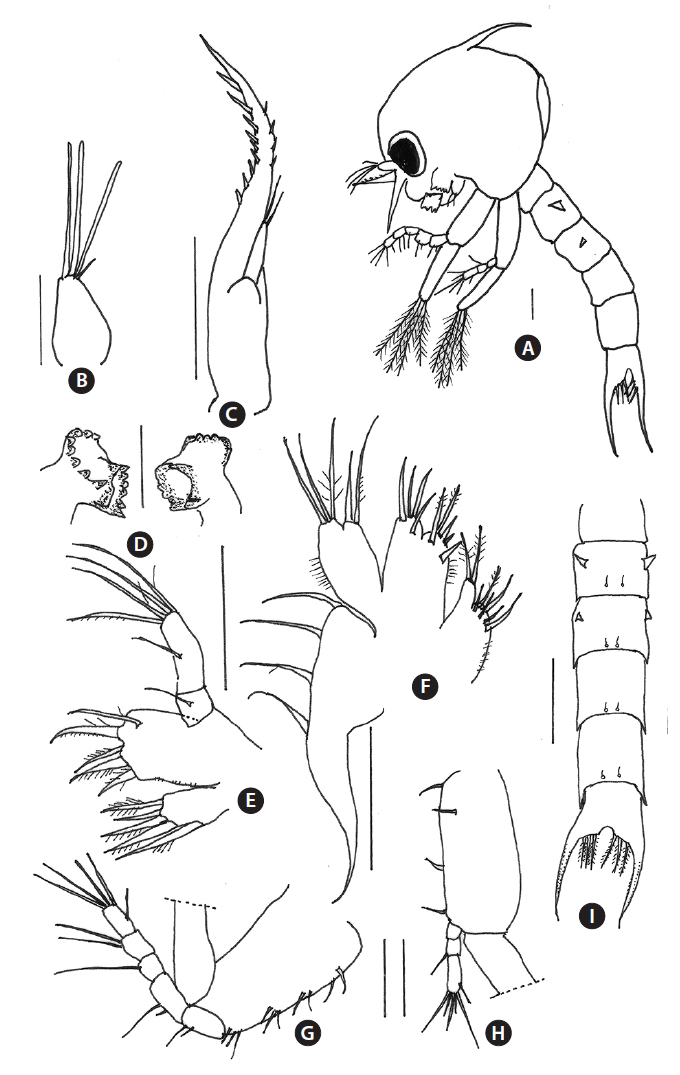The land crab Sesarma (Sesarma) intermedium (De Haan, 1835), belonging to the subfamily Sesarminae, is distributed in Korea, Japan, Taiwan, Hong Kong, the Mergui archipelago, and Surabaya (Kim, 1973). The zoeae of the genus Sesarma have been described from various areas, including the zoea of Sesarma (Sesarma) intermedium by Baba and Fukuda (1975) and Terada (1976), that of Sesarma (Holometopus) haematocheir by Fukuda and Baba (1976) and Terada (1974), that of Sesarma (Holometopus) dehaani by Baba and Miyata (1971) and Terada (1974), and that of Sesarma (Parasesarma) pictum by Aikawa (1937) and Terada (1974). The first zoea of Sesarma (Sesarma) intermedium from Japanese waters was described by Baba and Fukuda (1975); however, the description is inaccurate and inadequate for comparative morphological studies.
In this study, the first zoeal stage of Sesarmops intermedius [=Sesarma (Sesarma) intermedium] was described and illustrated in detail from laboratory-hatched material, and a morphological comparison based on the previous descriptions of Japanese Sesarma (Sesarma) intermedium was performed. In addition, the first zoeal characteristics of Sesarmops intermedius were compared with those of the three species Chiromantes haematocheir [=Sesarma (Holometopus) haematocheir], Chiromantes dehaani [=Sesarma (Holometopus) dehaani], and Parasesarma pictum [=Sesarma (Parasesarma) pictum] inhabiting Gangjeung, Seogwipo, Jeju Island.
On September 24, 2009, a pair of Sesarmops intermedius was collected in Gangjeung, Seogwipo, Jeju Island, transported to the laboratory, and held in an aquarium until hatching, which occurred on September 24, 2010. Newly hatched zoeae were preserved in 5% neutral formalin, and dissections were performed under a dissecting microscope. To prevent desiccation of specimens, a mixed solution of glycerin and ethanol was used for all dissections. Drawings were performed using the aid of a drawing tube at 100–400× magnification. Rostrodorsal length (RDL) was measured from the tip of the dorsal spine to the tip of the rostral spine, and carapace length (CL) was measured from the anterior margin between the eyes to the posterior margin of the carapace. The setal formula of the appendages is based on the proximal to the distal segments. The long plumose natatory setae on the exopods of the first and second maxillipeds are drawn truncated. Descriptions of the chromatophores are based solely on live specimens.
First zoea (Fig. 1)
[Fig. 1.] First zoea of Sesarmops intermedius (De Haan, 1835). A, lateral view; B, antennule; C, antenna; D, mandibles; E, maxillule; F, maxilla; G, first maxilliped; H, second maxilliped; I, abdomen and telson, dorsal view. Scale bars = 0.1 mm.
RDL, 0.79 (0.70–0.84) mm; CL, 0.53 (0.52–0.54) mm.
Carapace (Fig. 1A). With dorsal and rostral spines; lateral spine absent; dorsal spine slightly curved, as long as the rostral spine; rostral spine slightly longer than the protopod of the antenna; eyes unstalked.
Antennule (Fig. 1B). Uniramous, with three aesthetascs and one simple seta.
Antenna (Fig. 1C). Protopod tapered, slightly shorter than rostral spine, with two rows of small spinules; exopod with two terminal setae.
Mandibles (Fig. 1D). Asymmetrical; left mandible with teeth between incisor and molar processes; right mandible unarmed in that site.
Maxillule (Fig. 1E). Coxal endite with five setae; basal endite with five setae; endopod two-segmented, with one seta on proximal segment and five (one subterminal, four terminal) setae on the distal segment.
Maxilla (Fig. 1F). Coxal endite bilobed, with 2+6 setae; basal endite bilobed with 5+4 setae; endopod bilobed with 2+3 setae; scaphognathite with four marginal setae and one long posterior process.
First maxilliped (Fig. 1A, 1G). Basis with 10 setae arranged 2,2,3,3; endopod five-segmented, with 2,2,1,2,5 (one subterminal, four terminal) setae; exopod with four terminal natatory setae.
Second maxilliped (Fig. 1A, 1H). Basis with four setae arranged 1,1,1,1; endopod three-segmented, with 0,1,6 (one subterminal, five terminal) setae; exopod with four plumose natatory setae.
Abdomen (Fig. 1A, 1I). Composed of five somites; second to fifth somites with a pair of small setae postero-dorsally; second somite with pair of forward-directed dorsolateral processes; third somite with pair of backward-directed dorsolateral processes; pleopods not developed.
Telson (Fig. 1I). Bifurcated, with three pairs of serrate setae on posterior margin, with fine spinnules on inner and outer margin of fork.
Chromatophores. Blackish brown chromatophores present on overall surface of carapace, dorsal carapace spine, base of antennule, antenna, dorsal spine and rostral spine, optic and median ocular center, labrum, mandible, maxilla, basis of first and second maxillipeds, and on second to fifth abdominal somites and telson.
Baba and Fukuda (1975) described the first zoea of Sesarmops intermedius [=Sesarma (Sesarma) intermedium]. In the present study, some morphological characteristics were found to differ from their description, in particular the number of aesthetascs and seta of the antennule, the number of setae in the exopod of the antenna and the coxa of the maxilla, and the setation of the basis of the first and second maxillipeds. Moreover, they did not describe a pair of posterodorsal setae on the second to fifth abdominal somites. In addition, Terada (1976) described the first zoea of Sesarma (Sesarma) intermedium. Compared with the specimen described here, there are differences in the number of aesthetascs and seta of the antennule and in the number of setae in the coxa of the maxilla (Table 1).
A detailed comparison of the first zoeae of four sesarminid crabs—Sesarmops intermedius, Sesarma (Holometopus) haematocheir, Sesarma (Holometopus) dehaani, and Sesarma (Parasesarma) pictum—is presented in Table 2. The following similarities were found in the first zoeae of the four sesarminid crabs: the absence of lateral spines; the lateral processes on the second to third abdominal somites; the setation of the coxa (five setae), basis (five setae), and endopod (one, five setae) of the maxillule; the number of setae on the coxa (eight setae), basis (nine setae), endopod (five setae), and scaphognathite (four setae) of the maxilla; the setation of the endopod of the first maxilliped (2,2,1,2,5); and the setation of the endopod of the second maxilliped (0,1,6). The most useful criteria for distinguishing the first zoea of Sesarmops intermedius from the first zoeae of the other three sesarminid crabs are the exopod of the antenna with two setae and the antennule with three aethetascs and one simple seta.








